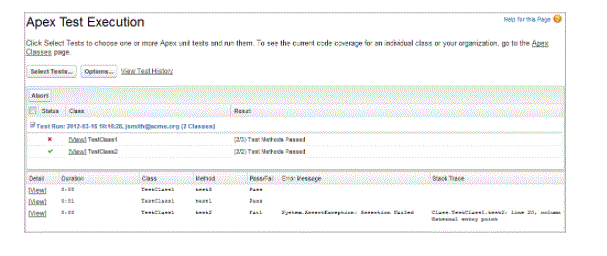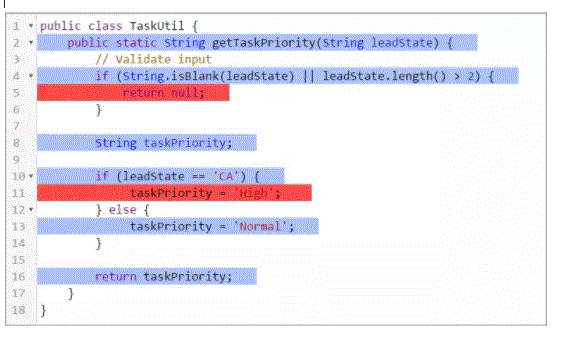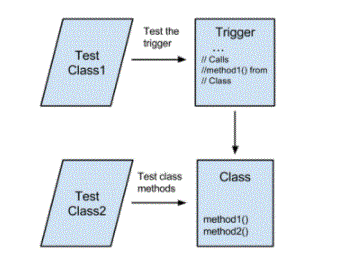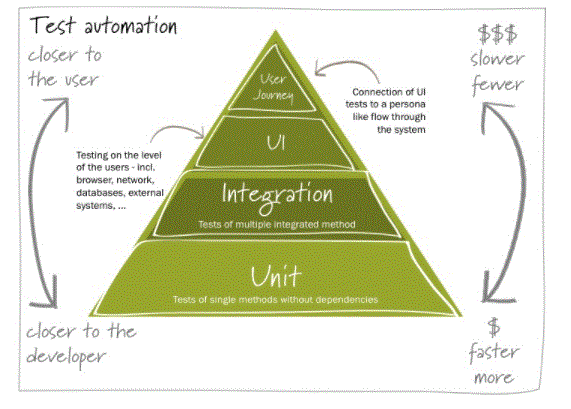
Apex provides a testing framework that allows you to write unit tests, run your tests, check test results, and have code coverage results. Let’s talk about unit tests, data visibility for tests, and the tools that are available on the Lightning platform for testing Apex.
- Introduction to Testing APEX
- Need for Apex Testing
- Why Test Apex?
- What is Tested in Apex?
- Apex Unit Test
- Test Data
- Running unit tests
- Understanding Test Data
- Benefits of Testing APEX
- Conclusion
Introduction to Testing APEX:
Testing is an essential component of Apex, as well as any software development. Individual test classes will be used in Apex to construct unit test cases. Testing is critical to the success of software development. Several experts advise us to always employ a test-driven development methodology. The produced code should be tested as soon as possible. As a result, those mistakes are frequently minimized.
Testing is that the key to successful long-term development and maybe a critical component of the event process. We strongly recommend that you simply use a test-driven development process, that is, test development that happens at an equivalent time as code development.

- Unit tests must conceal a minimum of three-by-fourth of our code; these tests must be completed efficiently.
- While implementing the appliance during a production enterprise, every unit test within the enterprise namespace is implemented automatically.
- Invoking system. debug isn’t considered as a component of apex code.
- Test classes and Test methods aren’t considered as a component of apex code.
- Each trigger should have a particular testing scope.
Need for Apex Testing:
If you’re developing a software package for end-users, then testing is that the key aspect of the success of that product. Testing is employed to check the given product, whether it’s working consistently with the expectations or not. Two methods for testing an application: a method of testing is with the assistance of the salesforce interface.
Testing through the salesforce interface makes the merchandise testing from different perspectives. differently of testing is testing bulk services, and you’ll send 200 records with the assistance of this code if you called through SOAP API. To implement the applications for salesforce App exchange, the subsequent rules should be satisfied.
Observe the following:
- Unit tests must cover at least 75% of your Apex code, and each of these tests must pass.
- Take note of what follows.
- When you deploy Apex to a production organisation, by default, each unit test in your organization’s namespace gets performed.
- Calls to System. debug aren’t counted as a part of Apex code coverage.
- Test methods and test classes aren’t counted as a part of Apex code coverage.
- While just 75% of your Apex code must be tested, don’t focus on the percentage of code that is covered. Instead, ensure that your application’s use cases are covered, covering positive and negative scenarios, as well as bulk and single records. This method ensures that at least 75% of your code is covered by unit tests.
- Every trigger must have some test coverage.
- All classes and triggers must compile successfully.
- Salesforce performs all tests for organisations with Apex code to ensure that no behaviour has changed as a result of service updates.
Why Test Apex?
Testing is vital to the success of your application, particularly if your application is to be deployed to customers. If you validate that your application works needless to say, that there are not any unexpected behaviors, your customers are getting to trust you more.
There are two ways of testing an application. One is thru the Salesforce interface, important, but merely testing through the interface won’t catch all of the utilization cases for your application. the opposite way is to check for bulk functionality: up to 200 records are often skilled your code if it’s invoked using SOAP API or by a Visualforce standard set controller.
An application is seldom finished. you’ll have additional releases of it, where you modify and extend functionality. If you’ve got written comprehensive tests, you’ll make sure that regression isn’t introduced with any new functionality.
The following must be true before you deploy your code or package it for the Salesforce AppExchange:

What is Tested in Apex?
Salesforce develops tests for the following:
1. Single Action- It is tested to see whether a private record generates an acceptable or expected result.
2. Bulk Actions- Any Apex code sort of a class or a trigger or extension is often involved 1 to 200 records. you ought to test individual or Bulk records.
3. Positive Behaviour– It is tested to see whether the assumed behavior happens in every assumed mutation.
4. Negative Behaviour- This behavior is taken into account as a restriction to the applications like cannot indicate a negative amount, cannot include future data, etc.
5. Restricted user- It is wont to test whether the user implements the code or gets error messages.

- Unit Tests Example
- @isTest
- Private class ACTE{
- Static void testing1() {
- Program statements
- }
- }
- Example1:
- Private class ACTE
- {
- @istest static void test_1
- {
- Test code to be executed.
- }
- @istest static void test_2
- {
- Test code to be executed.
- }
- }
Apex Unit Test:
To ease the event of strong and flawless code, Apex endorses the execution and creation of unit tests. Unit tests are considered class methods that test whether a selected part of code is functioning accurately. Methods of Unit tests will haven’t any arguments, won’t save data to the database. Unit tests should be laid out in the test classes, that are written with “@isTest”.
Test Data:
Apex test data is temporary and not saved within the database. After executing the test method, the inserted data isn’t saved within the database. All the modifications done to the available records aren’t saved or committed within the database.
- Few or total all test methods during a particular class.
- Few or full methods during a group of classes.
- An inbuilt collection of classes is called a test suite.
- Complete unit tests within the organization.
- Salesforce interface
- Salesforce expansions through visual studio code.
- API
- Lightning Platform Developer Console.
- Running Unit tests through the Salesforce Interface
- Choose a namespace of a managed package from the fold-out list to select a test within an installed package.
- Choose [My Namespace] from the fold-out list to select a test that exists at the local level of your company.
- Select [All Namespaces] from the fold-out list to select a test.
Running unit tests:
We’ll run the unit tests to see if the apex code is useful. We’ll use the developer console to run the apex test methods.
We may run the subsequent groupings of test cases:
We can run the unit tests through the following:
Steps for Running Unit Tests are as follows:
1. Type “Apex Test Execution” into the “Quick Find Box” in the Setup, then choose Apex Test Execution.
2. Press “select Tests”.
3. Choose the tests to run. The catalog of tests contains simply classes that comprise test methods:
4. To stop collecting code coverage data when running tests, select “Skip Code Coverage.”
5. Press Run.

- In unit tests, test data is isolated from organisational data.
- Using the isTest(SeeAllData=True) Annotation
- To enable data access to records in your organisation, annotate your test class or function with IsTest(SeeAllData=true).
- The IsTest(SeeAllData=true) annotation only applies to data queries, not record creation or updates, including deletions.
- Even when applying the annotation, new and modified entries are still rolled back in Apex tests.
- Loading Test Data
- Using the Test.loadData method, you’ll populate data in your test methods without having to write down many lines of code.
- Common Test Utility Classes for Test Data Creation
- Common test utility classes are public test classes that contain reusable code for test data creation.
- Using Test Setup Methods
- Use test setup methods (methods that are annotated with @testSetup) to make test records once then access them in every test method within the test class. Test setup methods are often time-saving once you got to create reference or prerequisite data for all test methods, or a standard set of records that each test methods operate.
Understanding Test Data:
Apex test data is ad hoc and is not saved in the database. This implies that when a test method completes execution, the information placed by the test does not continue the database. As a result, there is no need to erase any test data following a test. Similarly, all modifications to existing data, such as updates or deletions, are not retained. This ephemeral characteristic of test data simplifies knowledge management because no test data cleansing is required. Simultaneously, if your tests access organisational data, this prevents unintentional deletions or changes to existing records.
By default, existing organization data isn’t visible to check methods, except for certain setup objects. you ought to create test data for your test methods whenever possible. However, test code saved against Salesforce API version 23.0 or earlier has access to all or any data within the organization. Data visibility for tests is roofed in additional detail within next section.

- The following are the advantages of Apex unit tests.
- Ensuring that your Apex classes and triggers work needless to say
- Having a set of regression tests that will be rerun whenever classes and triggers are updated to make sure that future updates you create to your app don’t break existing functionality
- Meeting the code coverage requirements for deploying Apex to production or distributing Apex to customers via packages
- High-quality apps delivered to the assembly org, which makes production users more productive
- High-quality apps delivered to package subscribers, which increase your customer’s trust
Benefits of Testing APEX:
Conclusion:
In every software development, testing plays an important role in the form it is successful. In Apex also, testing is important to check the functionality of the merchandise. In Apex we’ll check the behavior and actions of the merchandise. we’ll have specific methods and classes to implement unit tests. Unit tests make the code error-free. during this way, we’ll test the apex code to develop a successful software package.





